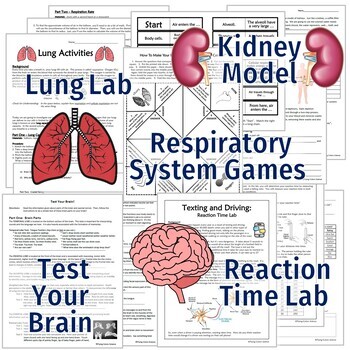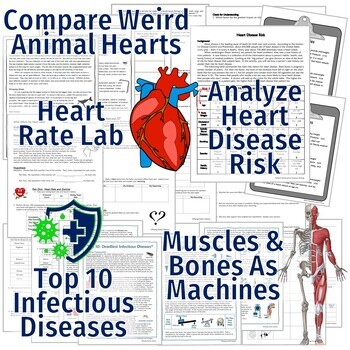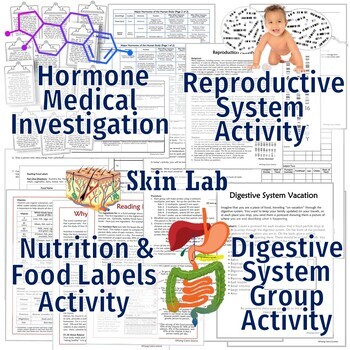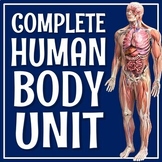Human Body Organ Systems Activity Bundle 15 FUN and ENGAGING Activities
- Zip
- Google Apps™
- Easel Activity

What educators are saying
Products in this Bundle (15)
showing 1-5 of 15 products
Also included in
- Never search for "something to do tomorrow" ever again! This bundle contains PRINT AND GO lessons, NO PREP activities, LOW PREP labs, and ENGAGING articles to supplement and thoroughly enhance a life science course. Every included resource is easy to implement, standards-based, and high-quality.Price $399.99Original Price $750.85Save $350.86
- SAVE OVER 40% off list prices! This is a complete ACTIVITY-BASED Organ Systems lesson unit. This bundle includes every resource I use to teach and assess NGSS MS-LS1-3. All of the work has been done for you - from start to finish! An included unit plan tells you what to teach and when, so you don'Price $109.00Original Price $186.36Save $77.36
Description
SAVE $20 off list prices! Includes human body systems activities that are easy on the teacher and fun for kids! Includes 15 FUN, fresh, and thoroughly engaging anatomy activities to supplement your Human Body Systems unit.
Teachers will appreciate these resources because:
- The included lessons are high-quality and content-dense - no fluff!
- These activities don't require anything more than very simple supplies, if any at all.
- You can trust these activities to be PRINT-AND-GO! They're easy to follow and very easy to implement.
Students will appreciate these resources because:
- The included activities are FUN! (Check out the customer reviews of this bundle, they repeatedly mention how much the kids enjoyed these activities!)
- Each varied activity is different than the next - from labs where students get to "test" their own bodies to activities where they get to think like a doctor.
- These activities relate human body studies to the real world, increasing student engagement.
This Bundle Includes:
- Digestive System - Nutrition and Food Labels Activity*
- Digestive System - Group Choice Projects (FREE BONUS)
- Respiratory System - Lung Investigation*
- Respiratory System - 2 Review Games
- Nervous System - Test Your Brain Investigation*
- Nervous System - Reaction Time Lab*
- Circulatory System - Evaluate Heart Disease Risk in Pretend Patients*
- Circulatory System - Compare Weird Animal Hearts to Human Hearts*
- Circulatory System - Heart Rate Lab*
- Immune System - Top 10 Infectious Diseases Article & Questions*
- Excretory System - Make a Model of a Kidney*
- Integumentary System - Skin Sensitivity Investigation*
- Musculoskeletal System - Muscles and Bones as Simple Machines*
- Endocrine System Activity - Hormones and Health Medical Investigation*
- Reproductive System - Gametes and Zygote Activity (for middle school!)
*Starred resources include both a printable PDF version and a Google Slides version.
Individual Resource Descriptions:
Digestive System - Food Label Activity: Students read about the basics of nutrition and how to read food labels. They'll answer questions on a corresponding worksheet and analyze a variety of food labels. Make it easy on yourself by having students bring in the labels! Both a printable PDF and a Google Slides version are included for this activity.
Digestive System - Group Choice Projects: FREE BONUS! Let groups decide how they want to demonstrate what they have learned about the digestive system. Included are directions for 3 different activities related to the digestive system - a skit, a detailed drawing, and vacation postcards. Groups of students decide which project they want to do!
Respiratory System - Lung Investigation: Very low prep and uses easy supplies to investigate respiration rate and lung capacity. Both a printable PDF and a Google Slides version are included for this activity.
Respiratory System - Review Games: Students review what they've learned about the respiratory system with two fun games - a "cootie catcher" foldable that reviews vocabulary and a chain puzzle that reviews the process of gas exchange in the lungs.
Nervous System - Test Your Brain Investigation: This activity guides students through several different "tests" and activities to learn about the different parts of their brains. It has a very easy supply list - I promise! Both a printable PDF and a Google Slides version are included for this activity.
Nervous System - Reaction Time Lab: Students read about the dangers of distracted driving and why nerve impulses are not instantaneous. Students will test their own reaction time in distracted and non-distracted conditions. The only supplies you need are rulers! Both a printable PDF and a Google Slides version are included for this activity.
Circulatory System - Evaluate Heart Disease Risk of Pretend Patients: Students read a brief background about heart disease and how doctors evaluate risk for heart disease. Students are provided a "Heart Disease Risk" chart, and use it to evaluate the risk factor score for 6 pretend patients, and then complete a quick analysis section. Both a printable PDF and a Google Slides version are included for this activity.
Circulatory System - Heart Rate Lab: FUN! Students study themselves in this anatomy investigation and even determine their own variable. This is a twist on the usual heart rate activity! And, this is a NO PREP lab! Both a printable PDF and a Google Slides version are included for this activity.
Circulatory System - Compare Weird Animal Hearts to Human Hearts: Students read an article about 8 of the strangest hearts in the animal kingdom - from a whale with a heart the size of a piano to an octopus that has 3 hearts. Students then complete a worksheet with text-dependent reading comprehension analysis questions. Both a printable PDF and a Google Slides version are included for this activity.
Immune System - Top 10 Infectious Diseases Reading & Questions: Students read about the 10 pathogens that cause major infectious diseases in world populations, how they spread, and how they affect the body. Both a printable PDF and a Google Slides version are included for this activity.
Excretory System - Make a Model of a Kidney: Students read a simple background about kidneys and how they work, answer some "Check for Understanding" questions, then follow simple instructions to create a model of a kidney. A brief analysis follows.
Integumentary System - Skin Sensitivity Investigation: Students test different areas of the body for sensitivity. The only materials required for this investigation are toothpicks and a thick paper (such as an index card) to tape them to. The student response sheet includes sections for Background, Hypothesis, Materials, a clear Procedure section, two Data Tables, and some simple analysis questions. Both a printable PDF and a Google Slides version are included for this activity.
Musculoskeletal System - Muscles and Bones as Simple Machines: Students read an article about how muscles and bones often function as simple machines such as wedges, levers, and pulleys. Then, students answer questions on a corresponding worksheet. No prior knowledge is required! Both a printable PDF and a Google Slides version are included for this activity.
Endocrine System - Hormones and Health Medical Investigation: Students get to think like a doctor as they evaluate the symptoms of 12 patients. they'll match the patient's symptoms to a hormone chart to find out which hormone may be causing their issues. No prior knowledge is required - this is more of a critical thinking activity! Both a printable PDF and a Google Slides version are included for this activity.
Reproductive System - Gametes and Zygote Activity: Appropriate for middle school! Students create a zygote with the chromosomes of two gametes. This brings home the point that the function of the reproductive system is to make specialized cells for reproduction. Please note that this resource does not include any mention of intercourse.
⭐Get all of these activities in our COMPLETE HUMAN BODY UNIT!
⭐Includes everything you need to TEACH and ASSESS Human Body Systems!
Teacher Notes:
- All answer keys are included.
- Please note: these documents are not editable.







